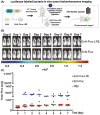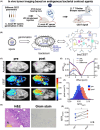Bacterial imaging in tumour diagnosis
- PMID: 38808743
- PMCID: PMC11135020
- DOI: 10.1111/1751-7915.14474
Bacterial imaging in tumour diagnosis
Abstract
Some bacteria, such as Escherichia coli (E. coli) and Salmonella typhimurium (S. typhimurium), have an inherent ability to locate solid tumours, making them a versatile platform that can be combined with other tools to improve the tumour diagnosis and treatment. In anti-cancer therapy, bacteria function by carrying drugs directly or expressing exogenous therapeutic genes. The application of bacterial imaging in tumour diagnosis, a novel and promising research area, can indeed provide dynamic and real-time monitoring in both pre-treatment assessment and post-treatment detection. Different imaging techniques, including optical technology, acoustic imaging, magnetic resonance imaging (MRI) and nuclear medicine imaging, allow us to observe and track tumour-associated bacteria. Optical imaging, including bioluminescence and fluorescence, provides high-sensitivity and high-resolution imaging. Acoustic imaging is a real-time and non-invasive imaging technique with good penetration depth and spatial resolution. MRI provides high spatial resolution and radiation-free imaging. Nuclear medicine imaging, including positron emission tomography (PET) and single photon emission computed tomography (SPECT) can provide information on the distribution and dynamics of bacterial population. Moreover, strategies of synthetic biology modification and nanomaterial engineering modification can improve the viability and localization ability of bacteria while maintaining their autonomy and vitality, thus aiding the visualization of gut bacteria. However, there are some challenges, such as the relatively low bacterial abundance and heterogeneously distribution within the tumour, the high dimensionality of spatial datasets and the limitations of imaging labeling tools. In summary, with the continuous development of imaging technology and nanotechnology, it is expected to further make in-depth study on tumour-associated bacteria and develop new bacterial imaging methods for tumour diagnosis.
© 2024 The Author(s). Microbial Biotechnology published by John Wiley & Sons Ltd.
Conflict of interest statement
The authors declare that there are no conflicts of interest.
Figures






Similar articles
-
High resolution in vivo bioluminescent imaging for the study of bacterial tumour targeting.PLoS One. 2012;7(1):e30940. doi: 10.1371/journal.pone.0030940. Epub 2012 Jan 25. PLoS One. 2012. PMID: 22295120 Free PMC article.
-
Magnetic resonance imaging (MRI) for the assessment of myocardial viability: an evidence-based analysis.Ont Health Technol Assess Ser. 2010;10(15):1-45. Epub 2010 Jul 1. Ont Health Technol Assess Ser. 2010. PMID: 23074392 Free PMC article.
-
Positron emission tomography for the assessment of myocardial viability: an evidence-based analysis.Ont Health Technol Assess Ser. 2010;10(16):1-80. Epub 2010 Jul 1. Ont Health Technol Assess Ser. 2010. PMID: 23074393 Free PMC article.
-
In vivo Imaging Technologies to Monitor the Immune System.Front Immunol. 2020 Jun 2;11:1067. doi: 10.3389/fimmu.2020.01067. eCollection 2020. Front Immunol. 2020. PMID: 32582173 Free PMC article. Review.
-
Luciferase-expressing Escherichia coli.2008 Jan 22 [updated 2008 Feb 5]. In: Molecular Imaging and Contrast Agent Database (MICAD) [Internet]. Bethesda (MD): National Center for Biotechnology Information (US); 2004–2013. 2008 Jan 22 [updated 2008 Feb 5]. In: Molecular Imaging and Contrast Agent Database (MICAD) [Internet]. Bethesda (MD): National Center for Biotechnology Information (US); 2004–2013. PMID: 20641415 Free Books & Documents. Review.
Cited by
-
Escherichia coli on colorectal cancer: A two-edged sword.Microb Biotechnol. 2024 Oct;17(10):e70029. doi: 10.1111/1751-7915.70029. Microb Biotechnol. 2024. PMID: 39400440 Free PMC article. Review.
-
Microbes Saving Lives and Reducing Suffering.Microb Biotechnol. 2025 Jan;18(1):e70068. doi: 10.1111/1751-7915.70068. Microb Biotechnol. 2025. PMID: 39844583 Free PMC article. No abstract available.
-
Thermal-responsive ultrasound activatable in situ production of therapeutics for real-time imaging and targeted tumor therapy.Theranostics. 2025 Mar 18;15(9):4212-4228. doi: 10.7150/thno.101714. eCollection 2025. Theranostics. 2025. PMID: 40213677 Free PMC article.
-
Engineered Bacteria for Disease Diagnosis and Treatment Using Synthetic Biology.Microb Biotechnol. 2025 Jan;18(1):e70080. doi: 10.1111/1751-7915.70080. Microb Biotechnol. 2025. PMID: 39801378 Free PMC article. Review.
References
-
- Andrei, P. , Battuello, P. , Grasso, G. , Rovera, E. , Tesio, N. & Bardelli, A. (2022) Integrated approaches for precision oncology in colorectal cancer: the more you know, the better. Seminars in Cancer Biology, 84, 199–213. - PubMed
Publication types
MeSH terms
Grants and funding
LinkOut - more resources
Full Text Sources
Medical

